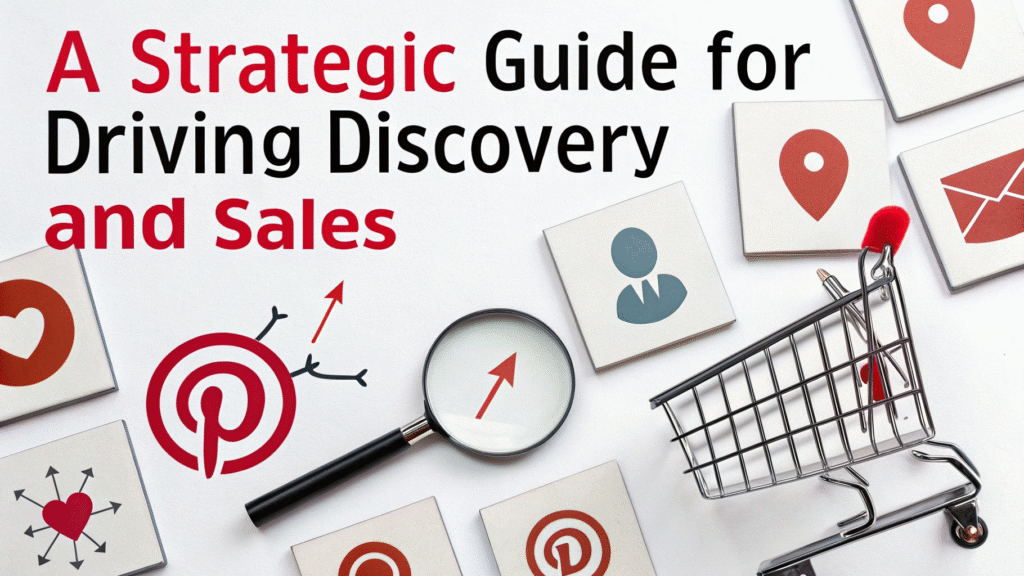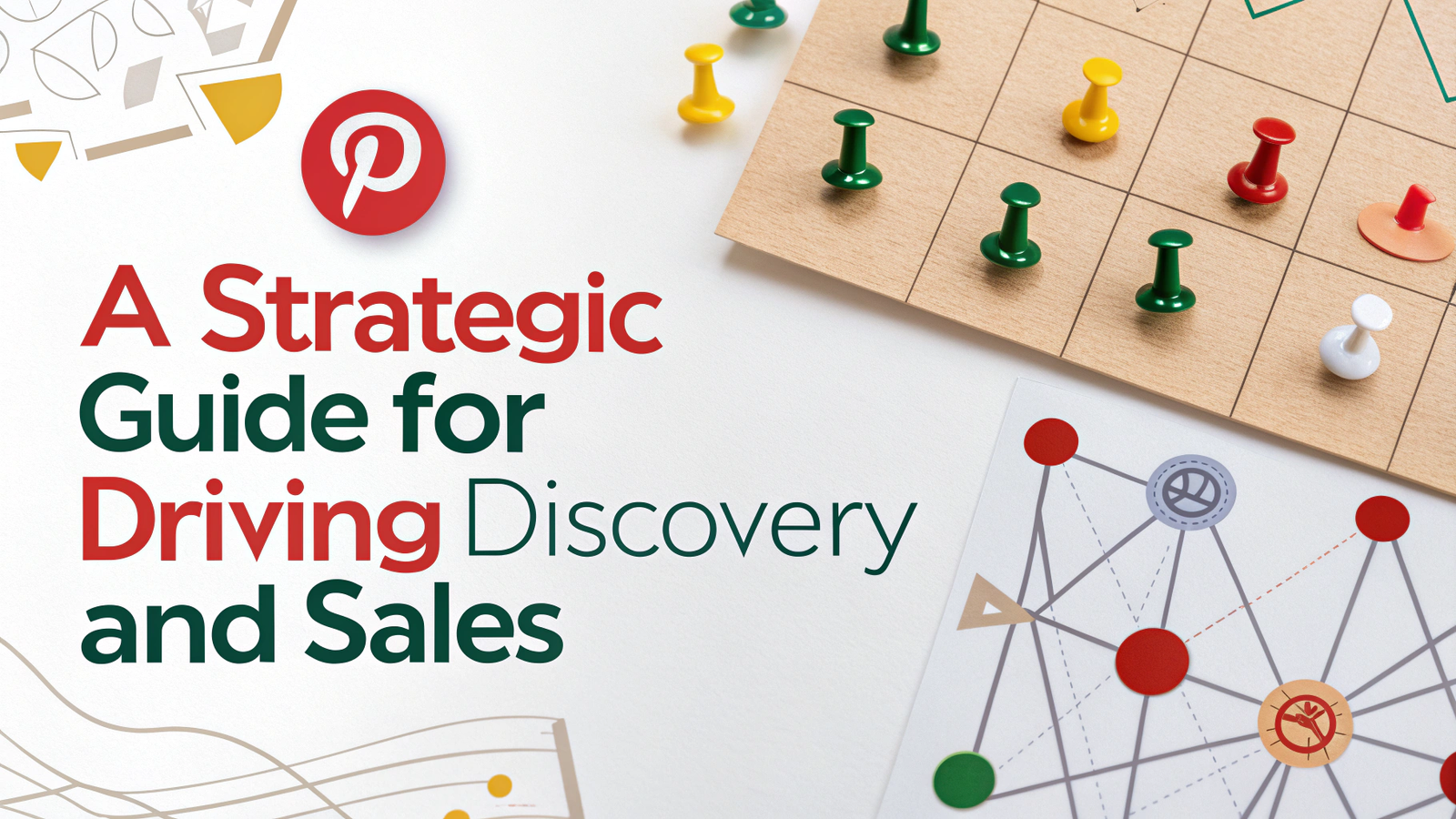
While many social platforms are designed for connection and conversation(Pinterest-marketing-guide-discovery), Pinterest operates on a different principle: inspiration and planning. Often described as a visual discovery engine, Pinterest is a powerful tool for entrepreneurs, marketers, and content creators looking to reach users with high commercial intent. Unlike the fleeting nature of other feeds, content on Pinterest has a long shelf life and actively drives purchasing decisions. This guide will demystify the platform and show you how to leverage its unique potential for your business.
Introduction: Beyond Social Media—A Visual Search Engine
Forget the notion of Pinterest as just another social network. It functions more like a visual search engine or a digital vision board. Users don’t come to passively scroll; they arrive with intent—to plan a wedding, find a recipe, redecorate a room, or discover their next style. This “planning mindset” is what sets Pinterest apart. Users are actively seeking ideas they can turn into action, making them highly valuable for brands. For businesses, this translates into an opportunity to be discovered by potential customers at the very beginning of their buying journey.
History & Evolution: From Idea Pinboards to a Global Platform
Pinterest’s journey began in 2010, co-founded by Ben Silbermann, Paul Sciarra, and Evan Sharp. The core concept was simple yet revolutionary: a digital pinboard to “pin” and organize inspiring images from across the web.
- 2010-2012: Niche Beginnings. The platform gained early traction with design-savvy, creative users who used it to collect ideas for DIY projects, home decor, and fashion.
- 2013-2015: Rapid Growth and Mobile Dominance. With the rise of smartphones, Pinterest’s visual, mobile-first design propelled it into the mainstream. The introduction of Rich Pins, which added real-time information like pricing and availability, marked its first major step toward e-commerce.
- 2016-Present: Becoming a Commerce and Inspiration Hub. Pinterest aggressively integrated shopping features, launching Buyable Pins and, more recently, a full suite of tools like Product Pins and shopping ads. The introduction of Idea Pins (similar to Stories) and video-focused features cemented its role as a destination for actionable inspiration.
Audience & Demographics: Connecting with Decision-Makers
Understanding who uses Pinterest is key to crafting an effective strategy. The platform boasts a unique and influential user base.
- Gender Skew: The audience leans female, with roughly 60% of users being women. However, male usage, particularly in categories like technology, automotive, and finance, is growing steadily.
- High Household Income: Pinterest users often have higher-than-average household incomes, meaning they have the purchasing power to act on their inspirations.
- Global Reach: With over 450 million monthly active users, Pinterest has a significant global presence, offering opportunities for international reach.
- Key Takeaway: This is an audience of planners and purchasers, not just browsers. They are actively making decisions about their lives, homes, and style.
Key Features & Functions for Marketers
Pinterest’s interface is built around Boards and Pins. Here’s how its key features work for businesses:
Pins: The Foundation of Content
A Pin is an image or video that users save to their boards. For brands, each Pin is a gateway to your website.
- Standard Pins: These are the core content unit. High-quality images with clear, descriptive text perform best.
- Video Pins: Video content, especially tutorials and “how-to” guides, sees high engagement and can be more effective at telling a story.
- Idea Pins: Similar to Stories, Idea Pins allow you to create multi-page video and image content that lives on your profile, perfect for step-by-step guides or showcasing a collection.
Boards: Organizing Your Brand’s Universe
Boards are collections of Pins centered around a specific theme. They help users and the Pinterest algorithm understand your content.
- Thematic Organization: Create boards for different product categories, project ideas, or content themes (e.g., “Summer Outfit Inspiration,” “Easy Weeknight Dinners,” “Office Decor Ideas”).
Pinterest Analytics: Your Strategic Compass
The built-in analytics dashboard is a powerful tool. It provides insights into:
- Top Pins and Boards: See what content resonates most with your audience.
- Audience Demographics: Understand the interests of your followers and those engaging with your content.
- Website Activity: Track how many people are visiting your site from Pinterest and what they’re clicking on.
Shopping on Pinterest
This is where the commercial intent truly shines.
- Product Pins: These are Pins tagged with product information, including real-time pricing, availability, and a direct link to purchase. They are essential for any e-commerce brand.
- Shopping Ads: Promoted Product Pins allow you to reach a larger, targeted audience actively searching for products like yours.
Business & Marketing Potential: Turning Inspiration into Action
The unique user mindset on Pinterest translates into tangible business benefits.
- Drive High-Quality Website Traffic: Pins are essentially visual bookmarks that link back to your site. Because users are in a discovery mode, the traffic driven from Pinterest is often highly qualified and has a longer-than-average session duration.
- Increase Brand Awareness and Inspiration: By consistently providing valuable, inspiring ideas, you position your brand as a leader in your niche. Users come to rely on you for inspiration.
- Boost Sales with High Purchase Intent: Studies consistently show that Pinners are more likely to make purchases both online and in-store based on what they see on the platform compared to users of other social networks.
- Extend Content Lifespan: A well-optimized Pin can continue to be discovered and drive traffic for months or even years, unlike the short lifespan of a typical social media post.
Best Practices & Tips for Success
To succeed on Pinterest, you need a strategic approach tailored to its visual and search-oriented nature.
- Optimize for Visual Search: Use high-quality, vertical images (aspect ratio of 2:3 is ideal) that are bright, clear, and visually appealing. Text overlay can be effective, but don’t let it clutter the image.
- Write Keyword-Rich Descriptions: Pinterest is a search engine. Use relevant keywords in your Pin descriptions, board titles, and board descriptions. Think about what your ideal user would type into the search bar.
- Enable Rich Pins: Ensure your website is set up with the correct meta tags to enable Rich Pins (Product, Article, Recipe). This automatically pulls in key information, making your Pins more useful and actionable.
- Pin Consistently and Strategically: Consistency is key. Use a scheduling tool like Tailwind (approved by Pinterest) to maintain a steady flow of content. Also, make sure to pin your content to the most relevant boards.
- Create Value-Driven Content: Focus on inspiring and helping your audience. “How-to” guides, tutorials, and inspirational ideas often perform better than straightforward product shots.
Challenges & Limitations
While powerful, Pinterest marketing comes with its own set of considerations.
- Longer Sales Cycle: Users are often in the early planning stages. It may take time for a Pin to lead to a sale, so it’s important to track metrics beyond immediate conversions.
- Requires a Content Library: To be effective, you need a steady stream of high-quality, original visual content.
- Niche Dependency: Some industries, like B2B services, may find it more challenging to gain traction compared to visually-oriented fields like fashion, food, and home decor.
- Algorithm Learning Curve: Understanding what the Pinterest algorithm favors (fresh content, keyword optimization, user engagement) takes time and testing.
Future Outlook: The Visual Future of Discovery
Pinterest is continuously evolving to make discovery and shopping more seamless.
- Augmented Reality (AR) Try-On: Pinterest is heavily investing in AR, allowing users to virtually “try on” makeup, eyewear, and even see how furniture would look in their home. This has enormous potential for reducing purchase hesitation.
- Video and Interactive Content: The platform is prioritizing video content, especially shoppable videos and interactive Idea Pins, as key formats for engagement.
- Deeper E-commerce Integration: Expect tighter integrations with e-commerce platforms and more features that shorten the path from inspiration to purchase, like in-app checkout capabilities.

Conclusion: Is Pinterest the Right Platform for Your Brand?
Pinterest is not a platform for every marketing strategy. However, if your business is visual, your target audience includes planners and purchasers, and you have valuable content or products to share, Pinterest offers an unparalleled opportunity. It’s a long-term play focused on building brand authority and capturing demand at the moment of discovery. By embracing its unique nature as a visual discovery engine, you can connect with a highly motivated audience and turn their inspiration into your sales.